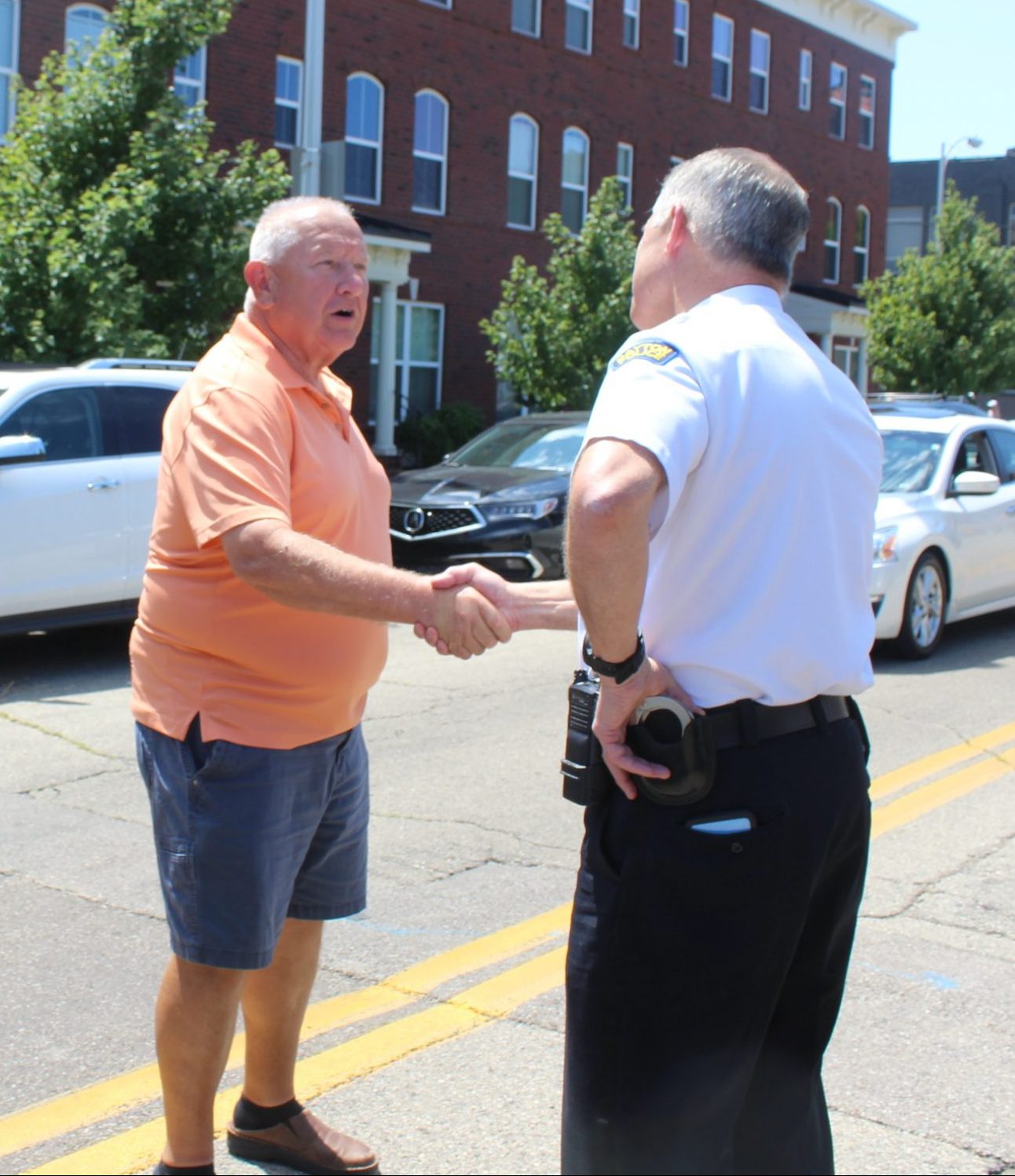Welcome Dayton Keynote – November 8, 2018
By Richard S. Biehl, Police Chief (RET)
*This is an article from the Spring 2022 issue of Combat Stress
Good Evening! I would like to extend an enthusiastic and heartfelt welcome to everyone attending, One City – Many People, Many Voices! This evening’s annual fundraising event is to support Welcome Dayton and the great work of HRC’s Immigrant Resource Specialists, Martha Jeanette and Eugenia, in serving our refugee and immigrant community members. I encourage you to be generous in that regard!
I would like to briefly share over the next several minutes a local journey and perhaps better labeled as a pilgrimage (a word often referring to the journey to a sacred place) through local, state and national immigration policies and practices.
Almost 11 years ago, I was appointed as police chief for the City of Dayton. I had not been police chief for even a month when I received an email that changed the trajectory of my path as police chief and propelled me into a decade-long road into the intricacies of immigration public policy and the challenges of finding a reasonable and compassionate path to better serve our immigrant and refugee community members. A portion of that email said the following:
“I hear repeatedly that cruisers are parked in the neighborhood near Latino households – having an excruciatingly intimidating effect on families.”
“The continuing arrests are causing near panic in some parts of East Dayton. Yesterday a family pulled their children out of our neighborhood school because they believe that the police are ‘hunting’ for undocumented Latino drivers when they drop their children off and pick them up after school.”
To read these comments was a shock to me. I could not imagine community members being so fearful of local police officers. I knew from my 30 years of public/community service at the time, that a significant contribution to the growth in crime and the increase in reported crimes that go unsolved is the absence of participation by community members in working with police officers, for which fear of the police can be a significant contributing factor.
So, I did what I have done so many times before when faced with such challenges, I searched for the truth. Were these reported actions true, was the expressed fear an understandable response to the direct experiences of community members?
A review of several months of jail intake data for 2007 and 2008, indicated that while arrests of Hispanic community members was small in number compared to total arrests, these arrests often led to I.C.E. removal, more often for traffic offenses than criminal arrests. The collateral effect of these arrests and subsequent I.C.E. removals was that families and children were left behind without support and therefore required support from local social service agencies. And what is also important to point out is that the I.C.E. removals occurred without a local trial or conviction of the most often, traffic charges.
During a Wall Street Journal feature story coverage, a Dayton resident thanks Chief Biehl and Dayton Police personnel for their heroic and decisive response to the Oregon District mass shooting. (August 2019)
The rationale in part for a portion of the arrests was the lack of identification of the persons that had encounters with local police. So, I had the policy of the Dayton Police Department revised restricting the physical arrest of persons for first time traffic offenses and requiring officers to make a good faith effort to solve an identity problem and to not make it become a jail problem. This policy applied to all community members in the City of Dayton. The greatest beneficiaries of this policy were Caucasian and African American community members. They comprised the bulk of those arrested for which the aggregate number of arrests for these two segments of the community dropped in 2011 to approximately 400 each annually from the 2008 levels of more than 1,300 and nearly 1,000 respectively for each group. The secondary effect for Hispanic community members was the reduced likelihood of I.C.E. removal for traffic charges that were never adjudicated by a court of law.
The reduction in the number of arrests that followed from this and other policies resulted in substantial savings for Montgomery County that had been spending hundreds of thousands of dollars a year to house prisoners in other jail facilities. Another benefit is that officers could better spend their limited time on more important local public safety matters like reducing serious crime.
So, these changes could be seen as soft on crime approaches. Yet, both serious and less serious violent crime declined steeply in 2011, the largest aggregate decline in violent crime in a decade. We, as a community, became safer!
Other policy changes followed such as the establishment of prohibitions against inquiring about the immigration status of victims or witnesses of crime and the development of clear policies for when I.C.E. is contacted when a suspect of a local crime is believed to lack legal status to be in the country. These policies focused on those persons who were a threat to national safety, involved in aggravated drug trafficking or were involved in serious, violent crime. Also, a formal relationship was forged with A.B.L.E. (Advocates for Basic Legal Equality) to assist immigrant crime victims/witnesses with U-Visa applications to protect them against deportation when they report crimes and work with legal authorities to solve those crimes.
Beyond local police policies, the Dayton Police Department advocated against state legislation in 2010 that would have mandated a role for local law enforcement to participate in immigration enforcement to include civil violations in conflict with an earlier Ohio General Attorney ruling that Ohio police officers lacked such federal enforcement authority.
I participated in the Capitol Hill visits in 2014 as a member of Bible, Badges and Business – a collaborative of business members, faith-based leaders, and law enforcement personnel nationally – to advocate for comprehensive immigration reform. I was so humbled to be a part of such well-informed and passionate Americans, many of whom identified themselves as conservative Republicans, who made the ardent case for immigration reform that was in support of our American businesses that are dependent upon workers from our diverse immigrant communities, that was compassionate and aligned with faith tradition values of this diverse country, and supported by law enforcement as in the best interests of public safety.
Additional activities in Washington included working with the National Immigration Forum’s, Law Enforcement Immigration Task Force, to work with federal administration officials to shape national law enforcement immigration policy and the limited role of local law enforcement that respects the public safety mission and goals of our local communities. Further, as a representative of the Dayton Police Department, in 2015 I testified before a subcommittee of the House of Representatives Judiciary Committee in opposition of House Resolution 3110 which would paint such a broad brush that any police agency that established policies with parameters constraining the role of local law enforcement in federal immigration enforcement could be deemed a “sanctuary city” with attendant punitive sanctions. And in 2016, I participated in a national press conference of the beginning of oral arguments in Texas et al. vs. the United States, a case that would determine significantly federal policies on DACA.
I should add as another footnote that while working on these issues locally and nationally, the city of Dayton experienced another record-breaking crime reduction in which both violent and property crime, serious and less serious, collectively declined more than 10% in 2017. The city of Dayton became safer!!
I would like to end my comments with some reflection of the vitriolic rhetoric that has too often emerged in the debate on federal immigration policy and the perceived needed changes. We have heard repeatedly that those in violation of immigration laws or seeking asylum from foreign lands (and I am significantly paraphrasing here) are incorrigible, untrustworthy, morally debased, and in some significant sense, less than human and thus not deserving of mere safety much less compassion.
These distorted characterizations bring to mind the comments of scholar Sam Keene who decades ago in his book, Faces of the Enemy: Reflections of the Hostile Imagination, illustrated how in times of war, “the enemy” is characterized in propaganda as inhuman, even bestial, and thus worthy of all the suffering and death that war brings. Keen commented that such characterizations were a projection of one’s inner fears and aggression upon the other and thus justifying a violent response. His commentary suggested that such emotions were better substance for inner resolution rather than externalized projection with all the subsequent harm that follows. He was subsequently criticized for psychologizing politics to which he replied, “Don’t politicize your psychology!” I will leave for your own reflection how much of our national dialogue on immigration has been a politicization of personal psychology.
So regardless of one’s own personal views on national immigration reform, I would suggest that there is an urgent need for deep reflection on our history as a nation of immigrants and to recall the words of the timeless sonnet by Emma Lazarus – “Give me your tired, your poor, your huddled masses yearning to breathe free” – that truly represent our country’s roots, national psyche and spirituality.
The urgent civic dialogue that is needed will require that we still our own inner fears of the “other,” squelch our inclination to aggression, and recognize our deepest identity and goodness in the faces of the immigrants and refugees in our lands, on our shores, and within sight of our horizons. 
To serve as an inspiration and instruction of how we will need to still ourselves for the dialogue and action to follow, I direct your attention to the brief video – Just Breathe!
ABOUT THE AUTHOR

Richard Biehl is the former Director and Chief of Police of the Dayton Police Department. He was appointed to this position by City Manager Rashad Young on January 28, 2008, and retired on July 30, 2021, after spending 13+ years as Chief of Police and nearly 43 years in public and community service.
Chief Biehl served 24+ years as a Cincinnati Police Officer and for the last six years of his Cincinnati career as an Assistant Police Chief. He commanded both the Investigations Bureau and the Administration Bureau. His principle areas of responsibility included Internal Investigations, Planning & Special Projects, Youth Services, Criminal Investigation, General Vice Control, and Intelligence.
In February 2004, he was appointed as the first Executive Director of the Community Police Partnering Center, a private nonprofit organization. Created in the aftermath of the civil unrest of 2001, the Partnering Center was established to work in partnership with the Cincinnati Police Department to train community stakeholders in problem solving methodologies to address community crime and disorder problems. In addition to leading many neighborhood crime reduction initiatives, in 2006 while Executive Director, Richard Biehl led the implementation of CeaseFire Cincinnati, a neighborhood gun violence reduction initiative using a public health approach for violence reduction modeled after CeaseFire Chicago and which led to reduced violence in the Avondale community.
As Police Chief for the Dayton Police Department, Chief Biehl partnered with the Trotwood Police Department and the Montgomery County Sheriff’s Office in 2008 to support community engagement in the Community Initiative to Reduce Gun Violence (CIRGV), a gun violence reduction initiative modeled after the Cincinnati Initiative to Reduce Violence, which resulted in reduction of group-related homicides in Dayton and surrounding communities.
Under his leadership, the Dayton Police Department received the following professional recognition:
- Finalist for the 2010, 2011, & 2015 Herman Goldstein Award for Excellence in Problem Oriented Policing.
- Recipient of the 2011 Ohio Crime Prevention Association’s Special Project Award.
- Recipient of the International Association Chiefs of Police Cisco Community Policing Award, 2011 and 2015.
- Chief Biehl was the 2011 recipient of the OACP (Ohio Association of Chiefs of Police) Chief Michael Kelly Excellence and Innovation in Policing Award and also the recipient of the 2014 Dayton Convention & Visitors Bureau Ambassadors Award for bringing the International Problem Oriented Policing Conference to Dayton in October 2013.
- In September 2019, President Trump awarded the Department of Justice Medal of Valor to Sergeant William Chad Knight and officers Brian Rolfes, Jeremy Campbell, Vincent Carter, Ryan Nabel and David Denlinger for their quick, decisive, and courageous engagement of the Oregon District mass shooting assailant, ending the tragic onslaught in 32 seconds.
- In October 2019 at the International Association of Chiefs of Police conference, President Donald Trump asked Chief Biehl and Assistant Chief Matt Carper to join him on stage in recognition of the brave acts of the six members of the Dayton Police Department that responded to the Oregon District mass shooting.
Chief Biehl was a former competitive powerlifter and martial artist and his athletic pursuits included regional, national, and international sporting events spanning 1976 to 1992.
Nearly 30 years ago, Chief Biehl began to practice yoga as a means to emerge from two years of chronic depression. In 2015, Chief Biehl authored the chapter, Trauma in the Theater of the Body, that was published in the book, Moving Consciously: Somatic Transformation through Dance, Yoga, and Touch (2015), and which discusses the potential of yoga to mitigate and heal trauma. In 2020, Chief Biehl completed a master’s degree in Mindfulness Studies at Lesley University. He has presented an introduction to mindfulness practice to several conferences and local workshops. He incorporates mindfulness within this yoga teaching.
Combat Stress Magazine
Combat Stress magazine is written with our military Service Members, Veterans, first responders, and their families in mind. We want all of our members and guests to find contentment in their lives by learning about stress management and finding what works best for each of them. Stress is unavoidable and comes in many shapes and sizes. It can even be considered a part of who we are. Being in a state of peaceful happiness may seem like a lofty goal but harnessing your stress in a positive way makes it obtainable. Serving in the military or being a police officer, firefighter or paramedic brings unique challenges and some extraordinarily bad days. The American Institute of Stress is dedicated to helping you, our Heroes and their families, cope with and heal your mind and body from the stress associated with your careers and sacrifices.

Leave A Comment
You must be logged in to post a comment.